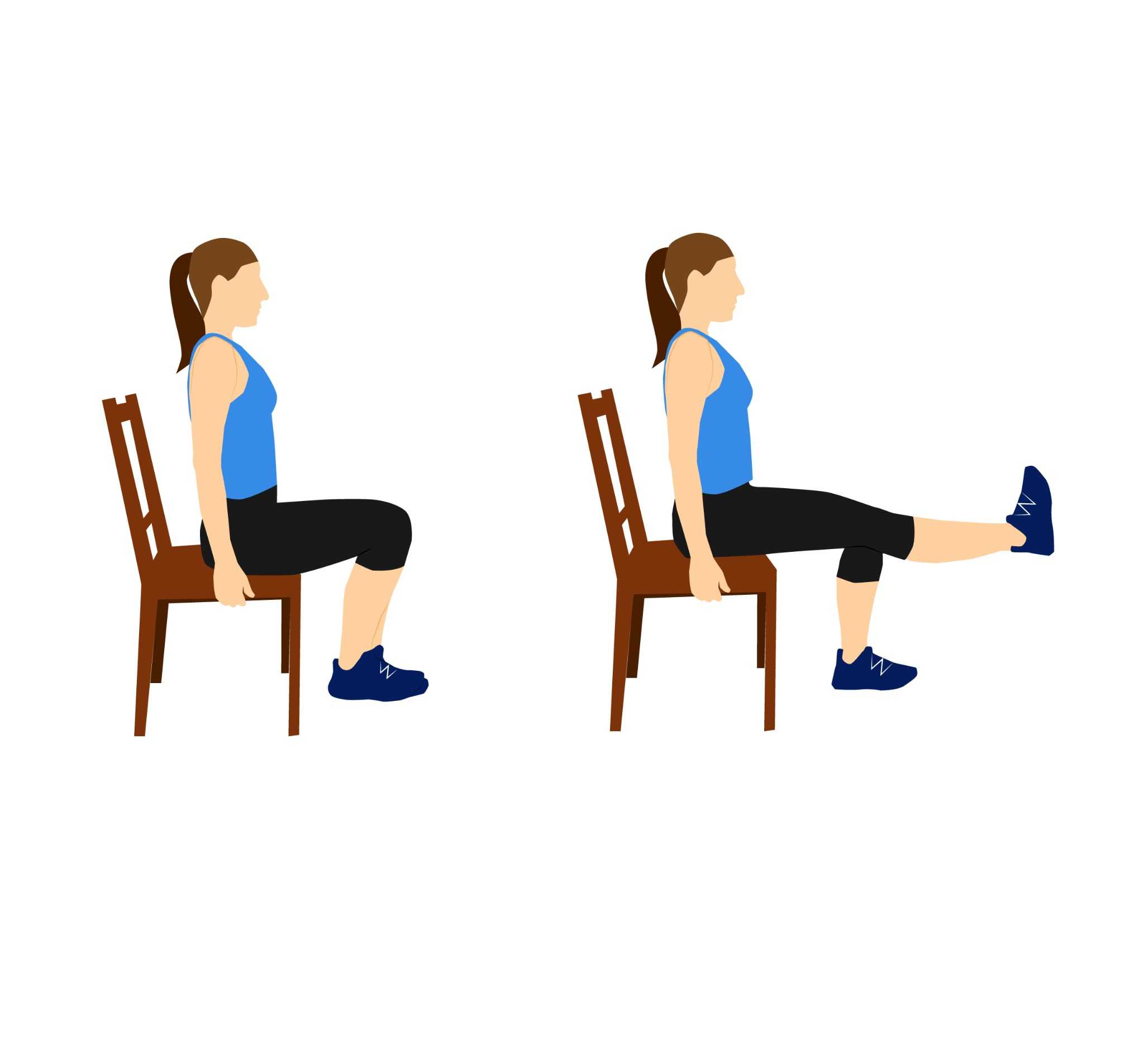The seated knee extension exercise is a powerful tool for strengthening the muscles surrounding the knee joint. This movement not only improves quadriceps strength but also supports knee health, stability, and mobility – all essential for various daily activities and athletic performance.
Whether you’re an athlete, rehabilitating an injury, or simply aiming for better leg strength, knee extension exercises are invaluable.
Read on to discover everything you need to know about seated knee extensions and related exercises that help build a stronger, healthier lower body.
Why Seated Knee Extensions Are Important for Joint Health
Knee joint health is crucial for maintaining an active lifestyle, especially as we age or recover from injuries. Integrating knee extension exercises into your workout routine can support knee stability, flexibility, and strength, reducing the risk of injury and making everyday movements easier.
The benefits include:
- Improved Stability: Strong quadriceps stabilise the knee joint, supporting activities like walking, climbing stairs, and even getting up from a seated position.
- Improved Mobility: Seated knee extension exercises contribute to the flexibility of knee joints, allowing for a broader range of movement.
- Increased Functionality: By strengthening knee muscles, these exercises improve overall leg function, making everyday activities smoother and less strenuous.
Incorporating tools such as a leg massager after workouts can also help relieve any soreness, making it easier to stay consistent with exercise routines.
Types of Knee Extension Exercises for Different Fitness Levels
From beginners to seasoned athletes, extension of the knee muscles through knee extension exercises offers varied options tailored to fitness levels and goals. Here are the main types:
1. Bodyweight Knee Extensions
These exercises are excellent for beginners as they use only body weight, making them easily accessible.
- Seated Knee Extensions: Sitting in a chair, lift one leg at a time to strengthen the knee. This basic version of the knee extension workout helps build fundamental quadriceps strength.
- Standing Knee Extensions: A more advanced option, standing knee extensions challenge your balance while activating stabilising muscles around the knee.
2. Resistance-Based Knee Extensions
As you progress, adding resistance to your knee extension workout increases intensity and effectiveness.
- Resistance Band Knee Extensions: Resistance bands add a layer of challenge, intensifying muscle engagement with each extension.
- Weighted Knee Extensions: Using ankle weights or gym machines, knee extension with weight exercises push the quadriceps further, strengthening them more effectively.
When to Progress: Recognising Signs of Strength Gains
Knowing when to progress in your seated knee extension exercises helps you build strength safely without overexerting your knees. Look for these signs that indicate you’re ready to add resistance or increase repetitions:
- Ease with Current Reps: If completing 10-15 repetitions feels effortless and doesn’t challenge your muscles, it may be time to increase resistance or reps.
- Stable, Controlled Movements: When each extension is smooth and controlled, with no strain or imbalance, your muscles are ready for additional challenge.
- Reduced Post-Exercise Soreness: Less soreness after workouts can indicate that your muscles have adapted and need more resistance to continue building strength.
Start by gradually adding resistance bands or ankle weights, or increase your repetitions slightly. Always prioritise form and avoid sudden increases to prevent injury.
How to Perform Seated Knee Extensions: A Step-by-Step Guide
The seated knee extension exercise is a simple yet effective way to strengthen the knee and quadriceps, promoting stability and function in the knee joint. Follow these steps to perform it with correct form and maximise the benefits.
Step 1: Get into Position
Begin by sitting comfortably in a sturdy chair. Place both feet flat on the floor, ensuring your back is straight and supported. Rest your hands on the sides of the chair to stabilise your upper body and keep the focus on the leg muscles.
Step 2: Extend the Knee
Choose one leg to start. Slowly extend it by straightening the knee, lifting the foot until your leg is parallel to the floor. As you extend, keep the foot flexed—this engages the quadriceps, the primary muscle group targeted by this exercise. Focus on moving with control rather than speed.
Step 3: Hold and Lower
Hold the extended position for 2-3 seconds, feeling the contraction in your thigh muscles. Slowly lower the leg back to the starting position, keeping the movement controlled. Avoid dropping the leg too quickly, as this could reduce muscle engagement and strain the knee.
Step 4: Repeat and Alternate
Repeat this movement with the other leg, aiming for 10-15 repetitions per leg. Perform 2-3 sets to allow both knees a balanced workout.
As your strength increases, consider adding a resistance band or ankle weights for additional challenge, gradually increasing intensity to further strengthen the quadriceps and knee stability.
Maximise Results with These Tips
To get the most out of your knee extension exercises, it’s important to focus on form and technique. Follow these expert tips to ensure each repetition is effective and safe, helping you achieve optimal results.
Warm Up Properly
Before starting, spend a few minutes warming up your lower body. Simple leg swings, light stretching, or gentle walking can help increase blood flow to the knee joint and surrounding muscles, reducing the risk of strain or injury.
Avoid Locking the Knee
As you extend the leg, avoid fully locking the knee. Stopping just short of full extension reduces undue strain on the joint, protecting your knee while still allowing the quadriceps to activate fully.
Controlled Movements
Perform each extension in a slow, deliberate manner. This controlled movement ensures the quadriceps are fully engaged, providing a better workout than fast or jerky movements, which can reduce effectiveness and increase the risk of strain.
Steady Breathing
Maintain a consistent breathing pattern to stabilise your movements. Exhale as you lift and extend the leg; inhale as you lower it back down.
Finally, consider incorporating a session in a massage chair post-workout to promote muscle relaxation and improve recovery, leaving your legs refreshed for the next session.
Common Mistakes to Avoid During Seated Knee Extensions
Performing seated knee extensions with proper form is essential for maximising benefits and avoiding unnecessary strain. Here are some common mistakes to be mindful of:
Using Momentum
One of the most frequent errors is relying on momentum by swinging the leg up quickly. While it may seem easier, this reduces muscle engagement, diminishing the exercise’s effectiveness. Instead, focus on slow, controlled movements that fully engage the quadriceps, allowing for a more targeted workout.
Misalignment
Another common mistake is letting the knee drift out of alignment with the thigh. Misalignment can cause discomfort or even lead to joint strain. Be sure that the knee moves directly in line with the thigh throughout the exercise to prevent added stress on the knee joint.
Holding Your Breath
Holding your breath can lead to unnecessary tension. Instead, maintain steady breathing—exhale as you extend the leg and inhale as you lower it back down. This helps keep you relaxed and promotes a smoother, more effective movement.
How Often Should You Do Knee Extension Exercises?
Consistency is crucial for building strength through knee extension exercises. For best results, aim to include these exercises in your routine 2-3 times per week, allowing at least one day of rest between sessions.
Beginners may start with a single set of 10-15 repetitions, while those more advanced can aim for 2-3 sets, gradually adding resistance for further challenge.
Additional Exercises to Complement Knee Extensions
For a well-rounded lower-body workout that promotes balanced muscle strength and knee stability, consider adding these exercises alongside knee extension workouts:
- Hamstring Curls: Target the hamstrings, or the muscles at the back of the thigh, to support knee stability and balance out the work done by the quadriceps. Strong hamstrings reduce strain on the knee and improve overall leg function.
- Calf Raises: Strengthen the calf muscles, which play a crucial role in supporting both the knee and ankle joints. Calf raises improve ankle stability and improve balance, making daily activities and exercise safer and more efficient.
- Step-Ups: This functional exercise improves balance and builds muscle endurance in the legs. By strengthening the quadriceps, hamstrings, and calves, step-ups reinforce knee stability and prepare the legs for activities like climbing stairs, walking, and even running.
- Terminal Knee Extensions: This specific type of knee extension focuses on strengthening the end range of the knee joint. Terminal extension knee help improve alignment, stability, and control around the knee, making them valuable for those aiming to enhance joint strength and prevent injuries.
Incorporating these exercises will help ensure balanced strength throughout the legs, reducing the risk of strain and supporting overall mobility.
Building a Lower-Body Routine with Knee Extensions
Knee extension exercises work well as part of a comprehensive lower-body workout. Here’s a sample routine to integrate them effectively:
- Warm-Up: Start with 5-10 minutes of light cardio or dynamic stretching.
- Seated Knee Extensions: Perform 2-3 sets of 10-15 reps per leg, adding resistance if desired.
- Hamstring Curls: Complete 2 sets of 10-12 reps.
- Calf Raises: Do 2 sets of 15 reps to strengthen the calves.
- Cool Down: End with gentle stretching for the quadriceps, hamstrings, and calves to promote flexibility.
Adaptations for Home Workouts
One of the greatest advantages of seated knee extension exercises is their flexibility, making them perfect for home workouts. With minimal equipment, you can achieve an effective and targeted workout for your knee and leg muscles.
Here are some ways to perform these exercises effectively at home:
- Use Resistance Bands: Resistance bands are lightweight, portable, and easy to use. Looping a band around your feet or ankles during each extension adds resistance, improving muscle engagement and strength without bulky equipment.
- Modify Intensity: For beginners, starting without weights allows focus on form. As you progress, you can add ankle weights or increase repetitions to intensify the workout. These adjustments challenge your muscles further and promote strength gains over time.
- Ensure Stability: Choose a sturdy chair or stable surface for your exercises. A solid base helps maintain correct posture, reducing strain on your back and hips, and keeps movements controlled and focused.
- Post-Exercise Relaxation: After exercising, consider using a portable massager to ease muscle tension, especially around the knee and quadriceps. This promotes relaxation and supports recovery, leaving your muscles refreshed for the next session.
Variations of Seated Knee Extensions for Progressive Strength
For continued muscle growth and strength, consider adding variations to your seated knee extension workout:
- Longer Holds: Extend hold times for increased muscle endurance.
- Increased Resistance: Use ankle weights to challenge the quadriceps further, improving leg strength and stability.
Common Questions About Knee Extensions
How often should seated knee extensions be performed?
For optimal results, perform seated knee extensions 2-3 times a week, allowing rest days for muscle recovery.
Are seated knee extensions suitable for everyone?
Yes, these exercises are generally safe, though individuals with specific joint concerns should consult a healthcare professional for tailored advice.
Can knee extensions assist with injury recovery?
Absolutely. Knee extension exercises are commonly used in rehabilitation to restore knee strength and stability after an injury.
Knee Extensions for a Stronger Lower Body
Adding seated knee extensions to your fitness routine offers numerous benefits, from improved leg strength to improved knee stability.
With consistent practice, you’ll notice stronger, more stable knees, making daily activities easier and supporting your long-term mobility goals. Keep progressing with these simple yet effective exercises to enjoy the full spectrum of their benefits.
Strengthen Your Knees with OSIM’s Wellness Solutions
Explore how seated knee extension exercises can benefit your knee health with OSIM’s advanced wellness equipment, designed to support your strength-building journey effectively and safely.




